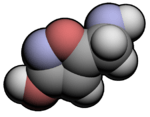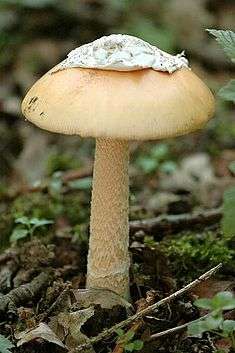Muscimol
 | |
 | |
| Names | |
|---|---|
| IUPAC name
5-(Aminomethyl)-isoxazol-3-ol | |
| Identifiers | |
3D model (JSmol) |
|
| ChEBI | |
| ChEMBL | |
| ChemSpider | |
| ECHA InfoCard | 100.018.574 |
PubChem CID |
|
| |
| |
| Properties[1] | |
| C4H6N2O2 | |
| Molar mass | 114.10 g·mol−1 |
| Melting point | 184 to 185 °C (363 to 365 °F; 457 to 458 K) |
| very soluble | |
| Solubility in ethanol | slightly soluble |
| Solubility in methanol | very soluble |
| Pharmacology | |
| Legal status |
|
Except where otherwise noted, data are given for materials in their standard state (at 25 °C [77 °F], 100 kPa). | |
| Infobox references | |
Muscimol (also known as agarin or pantherine) is one of the principal psychoactive constituents of Amanita muscaria and related species of mushroom. Muscimol is a potent, selective agonist for the GABAA receptors and displays sedative-hypnotic, depressant and hallucinogenic psychoactivity. This colorless or white solid is classified as an isoxazole.
Biochemistry
Muscimol is the psychoactive compound responsible for the effects of Amanita muscaria intoxication. Ibotenic acid, a neurotoxic secondary metabolite of Amanita muscaria, serves as a prodrug to muscimol when the mushroom is ingested or dried, converting to muscimol via decarboxylation.
Muscimol is produced in the mushrooms Amanita muscaria (fly agaric) and Amanita pantherina, along with muscarine, muscazone, and ibotenic acid.[2][3] A. muscaria and A. pantherina should be eaten with caution and prepared properly to lessen effects of nausea; It is disputed whether any official deaths from poisoning have been recorded from A. muscaria and A. pantherina.[4][5] In A. muscaria, the layer just below the skin of the cap contains the highest amount of muscimol, and is therefore the most psychoactive portion.[6]

Pharmacology

Muscimol is a potent GABAA agonist, activating the receptor for the brain's principal inhibitory neurotransmitter, GABA. Muscimol binds to the same site on the GABAA receptor complex as GABA itself, as opposed to other GABAergic drugs such as barbiturates and benzodiazepines which bind to separate regulatory sites.[7] GABAA receptors are widely distributed in the brain, and so when muscimol is administered, it alters neuronal activity in multiple regions including the cerebral cortex, hippocampus, and cerebellum. While muscimol is normally thought of as a selective GABAA agonist, it is also a partial agonist at the GABAA-rho receptor, and so its range of effects results from a combined action at both targets.[8]
The psychoactive dose of muscimol is around 10–15 mg for a normal person.[9] A Guide to British Psilocybin Mushrooms by Richard Cooper published in 1977 recommends a smaller dose, 8.5 mg, and suggests that it is possible for this amount to be present in as little as 1 g of dried A. muscaria[10] but this is not consistent with most other reports which suggest 5–10 g is necessary. A correct dose may be difficult to determine because potency varies dramatically from one mushroom to the next.[9]
When consumed, some percentage of muscimol goes un-metabolized and thus excreted in urine, a phenomenon exploited by practitioners of the traditional entheogenic use of Amanita muscaria.[11]
In patients with Huntington's disease and chronic schizophrenia, oral doses of muscimol have been found to cause a rise of both prolactin and growth hormone.[12]
During a test involving rabbits connected to an EEG, muscimol presented with a distinctly synchronized EEG tracing. This is substantially different from serotonergic psychedelics, with which brainwave patterns generally show a desynchronization. In higher doses (2 mg/kg via IV), the EEG will show characteristic spikes.[13]
Effects
The effects of the Amanita mushrooms begin 30–120 minutes after consumption and the effects last for 5–10 hours. Some of the desired effects include euphoria, dream-like (lucid) state of mind, out-of-body experiences and synesthesia. Neutral effects include dizziness, clumsiness, feeling of increased physical strength, loss of equilibrium, and glassy eyed stare. Calming effects may be felt, but completely opposite effects such as extreme energy bursts have been described. Negative effects include mild to moderate nausea, stomach discomfort, increased salivation and muscle twitching or tremors. In large doses strong dissociation or delirium may be felt.[14]
Many of muscimol's effects are consistent with its pharmacology as a GABAA receptor agonist, presenting many depressant or sedative-hypnotic effects. Atypical of the effect profile of sedative drugs generally however, muscimol, like Z-drugs, can cause hallucinogenic changes in perception. The hallucinogenic effect produced by muscimol is most closely comparable to the hallucinogenic side effects produced by some other GABAergic drugs such as zolpidem.
Jonathan Ott describes the effects of Amanita pantherina below:
About 90 minutes after ingestion ... I noticed that I was experiencing changes in visual perception. These effects became stronger over the next hour or some, and were characterized by sensing an 'alive quality' in inanimate objects, wavy motion in the visual field like a Van Gogh canvas ... and mild distortion of size, distance and depth perception. Auditory hallucination were also prominent -- especially the effect, called 'anahata sounds' of yoga, of hearing fine high-pitched sounds like bells and violin strings.[15]
Synthesis
It can be produced synthetically from the lithium acetylide derived from propargyl chloride. Treatment with ethyl chloroformate afford ethyl 4-chlorotetrolate, which condenses with hydroxylamine to give the chloromethylisoxazole. Anhydrous ammonia converts this chloride to muscimol.[16] The overall yield achieved in the literature was 18.7%.
Toxicity
The LD50 in mice is 3.8 mg/kg s.c, 2.5 mg/kg i.p. The LD50 in rats is 4.5 mg/kg i.v, 45 mg/kg orally.[17]
Legal status
Australia
Muscimol is considered a Schedule 9 prohibited substance in Australia under the Poisons Standard (October 2015). A Schedule 9 substance is a substance "which may be abused or misused, the manufacture, possession, sale or use of which should be prohibited by law except when required for medical or scientific research, or for analytical, teaching or training purposes with approval of Commonwealth and/or State or Territory Health Authorities."[18]
See also
References
- ↑ The Merck Index, 12th Edition
- ↑ Chilton, WS; Ott, J (1976). "Toxic metabolites of Amanita pantherina, A. Cothurnata, A. Muscaria and other Amanita species". Lloydia. 39 (2–3): 150–7. PMID 985999.
- 1 2 Michelot, D; Melendez-Howell, LM (2003). "Amanita muscaria: chemistry, biology, toxicology, and ethnomycology". Mycological Research. 107 (Pt 2): 131–46. doi:10.1017/S0953756203007305. PMID 12747324.
- ↑ https://www.bayareamushrooms.org/education/further_reflections_amanita_muscaria.html
- ↑ Tupalska-Wilczyńska, K; Ignatowicz, R; Poziemski, A; Wójcik, H; Wilczyński, G (1996). "Poisoning with spotted and red mushrooms--pathogenesis, symptoms, treatment". Wiadomości Lekarskie (in Polish). 49 (1–6): 66–71. PMID 9173659.
- ↑ Chilton, WS (1978). "Chemistry and Mode of Action of Mushroom Toxins". In Rumack, BH; Salzman, E. Mushroom Poisoning: Diagnosis and Treatment. Palm Beach: CRC Press. pp. 87–124. ISBN 9780849351853.
- ↑ Frølund, B; Ebert, B; Kristiansen, U; Liljefors, T; Krogsgaard-Larsen, P (2002). "GABA-A receptor ligands and their therapeutic potentials". Current Topics in Medicinal Chemistry. 2 (8): 817–32. doi:10.2174/1568026023393525. PMID 12171573.
- ↑ Woodward, RM; Polenzani, L; Miledi, R (1993). "Characterization of bicuculline/baclofen-insensitive (rho-like) gamma-aminobutyric acid receptors expressed in Xenopus oocytes. II. Pharmacology of gamma-aminobutyric acidA and gamma-aminobutyric acidB receptor agonists and antagonists". Molecular Pharmacology. 43 (4): 609–25. PMID 8386310.
- 1 2 "Erowid Psychoactive Amanitas Vault : Dosage". www.erowid.org. Retrieved 2018-04-05.
- ↑ Richard., Cooper, (1979). A guide to British Psilocybin mushrooms (Rev ed.). London (BCM Box 311, London, WC1V, 6XX): Hassle Free Press. ISBN 9780861660049. OCLC 7605366.
- ↑ Goldstein A. (2001). Addiction: From Biology to Drug Policy. Oxford University Press. p. 228. ISBN 978-0-19-514664-6.
- ↑ Tamminga, CA; Neophytides, A; Chase, TN; Frohman, LA (1978). "Stimulation of prolactin and growth hormone secretion by muscimol, a gamma-aminobutyric acid agonist". The Journal of Clinical Endocrinology and Metabolism. 47 (6): 1348–51. doi:10.1210/jcem-47-6-1348. PMID 162520.
- ↑ Carolis, A. Scotti De; Lipparini, F.; Longo, V. G. (1969-01-01). "Neuropharmacological investigations on muscimol, a psychotropic drug extracted from Amanita muscaria". Psychopharmacologia. 15 (3): 186–195. doi:10.1007/BF00411168. ISSN 0033-3158.
- ↑ "Erowid Psychoactive Amanitas Vault : Effects". www.erowid.org. Retrieved 2018-04-05.
- ↑ Ott, Jonathan (June 11, 2000). "Studies of Amanita: experience with Amanita muscaria (ID 366)". Erowid.org.
- ↑ McCarry, Brian E.; Savard, Marc (1981). "A facile synthesis of muscimol" (PDF). Tetrahedron Letters. 22 (51): 5153–5156. doi:10.1016/S0040-4039(01)92445-1.
- ↑ "Erowid Psychoactive Amanitas Vault : Chemistry". www.erowid.org. Retrieved 2018-04-05.
- ↑ Poisons Standard October 2015 https://www.comlaw.gov.au/Details/F2015L01534
